Air compressors produce compressed air and have a wide variety of industrial uses, including as power sources in factories. Hitachi first began manufacturing air compressors in 1911, and since then its air compressors have evolved with the passing decades to meet various needs. In recent years, Hitachi has been working in particular on energy saving and high efficiency. Hitachi oil-free scroll compressors, which produce clean compressed air that does not contain oil, are also equipped with an inverter, which reduces power consumption. Furthermore, the new Hitachi screw compressor series is equipped with an “air use point pressure prediction control” function that saves energy by reducing waste pressure. This control technology is installed standard in the 22- to 100-kW models of the Hitachi oil-flooded rotary screw compressor series and in the 15- to 120-kW models of the Hitachi oil-free rotary screw compressor series. Moving forward into the future, Hitachi will contribute to reducing CO2 emissions and preventing global warming while responding rapidly to customer needs through the manufacture, sale, and servicing of air compressors.
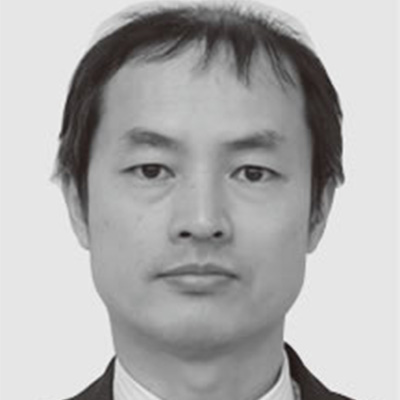
Air Compressor Design Department, Air Compressor Systems Division, Business Operations Group, Hitachi Industrial Equipment Systems Co., Ltd.Current work and research: Development of scroll compressors.

Air Compressor Design Department, Air Compressor Systems Division, Business Operations Group, Hitachi Industrial Equipment Systems Co., Ltd.Current work and research: Development of scroll compressors.

Air Compressor Design Department, Air Compressor Systems Division, Business Operations Group, Hitachi Industrial Equipment Systems Co., Ltd.Current work and research: Development of screw compressors.
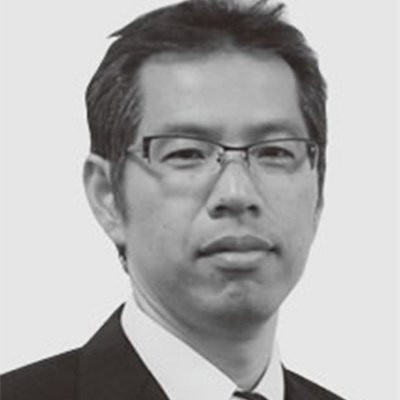
Air Compressor Design Department, Air Compressor Systems Division, Business Operations Group, Hitachi Industrial Equipment Systems Co., Ltd.Current work and research: Development of screw compressors.
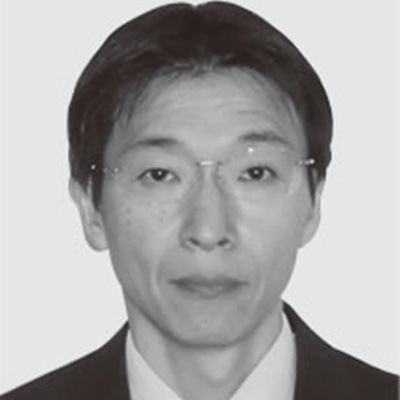
Air Compressor Design Department, Air Compressor Systems Division, Business Operations Group, Hitachi Industrial Equipment Systems Co., Ltd.Current work and research: Development of screw compressors.
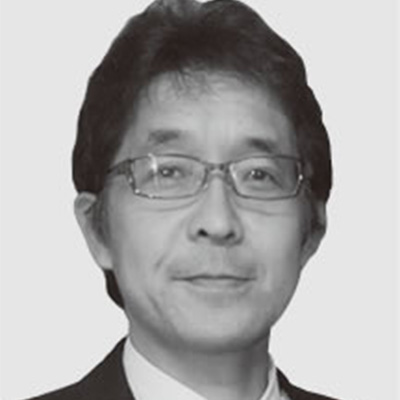
Home Appliances Research Department, Center for Technology Innovation - Mechanical Engineering, Research & Development Group, Hitachi, Ltd.Current work and research: Development of efficiency improvement technology for air compressors. Society memberships: The Japan Society of Mechanical Engineers (JSME), and Japan Society of Refrigerating and Air Conditioning Engineers (JSRAE).

Home Appliances Research Department, Center for Technology Innovation - Mechanical Engineering, Research & Development Group, Hitachi, Ltd.Current work and research: Development of efficiency improvement technology for air compressor.
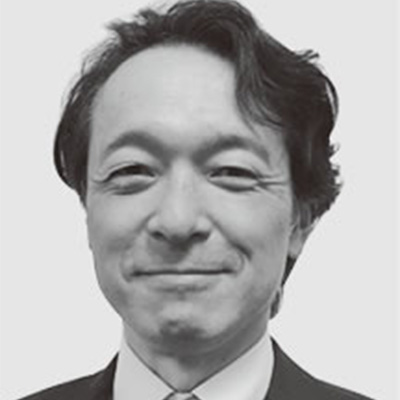
Intellectual Property Department, R&D Center, Hitachi Industrial Equipment Systems Co., Ltd.Current work and research: Management and exploitation of intellectual property rights.
Air compressors are an essential air source used in facilities such as factories, and the power consumption of air compressors accounts for the majority of the total power consumed in factories. Therefore, with the growing awareness of the environment and energy conservation in recent years, demand has also been growing for products with high energy-saving performance, including for air compressors.
The use of inverters is a widely known method for increasing the energy savings of air compressors.
Accordingly, this paper begins by describing oil-free scroll compressors equipped with an inverter.
Oil-free scroll compressors offer the advantages of clean air and low noise, and various other benefits, including energy savings, can be obtained by equipping them with an inverter.
On the other hand, Hitachi screw compressors have previously delivered energy savings and high efficiency through a variety of mechanisms and control technologies. In particular, the new Hitachi screw compressor series are equipped with “air use point pressure prediction control” which automatically reduces the operating pressure on the upstream compressor side while maintaining the minimum air use point pressure in the compressed air pipe system by predicting the pressure loss in the piping to increase energy savings even further over previous models. This paper gives an overview of this air use point pressure prediction control and introduces its effectiveness.
Figure 1 — Oil-free scroll compressor directly driven by an amorphous motor (7.5 kW)
 This air compressor is manufactured by Hitachi Industrial Equipment Systems Co., Ltd., which began selling it in 2017. Energy-saving performance has been increased by using an inverter to drive the amorphous motor, which has efficiency equivalent to IE5. Furthermore, the volume of the product has been greatly reduced by combining the amorphous motor and compressor into a single unit.
This air compressor is manufactured by Hitachi Industrial Equipment Systems Co., Ltd., which began selling it in 2017. Energy-saving performance has been increased by using an inverter to drive the amorphous motor, which has efficiency equivalent to IE5. Furthermore, the volume of the product has been greatly reduced by combining the amorphous motor and compressor into a single unit.
Hitachi Industrial Equipment Systems Co., Ltd. developed and began selling 3.7/5.5-kW inverter-controlled oil-free scroll compressors in 2014, and also began selling an oil-free scroll compressor directly driven by an amorphous motor in March 2017 (see Figure 1). The features of these products are described below.
To increase the energy savings of air compressors, it is important (1) to perform operation that matches the level of air consumption (optimal volume), and (2) to avoid operation at a compression level higher than needed (optimal pressure). This product delivers both of the above items simultaneously by controlling the rotational speed of the compressor using an inverter. The energy-saving performance has also been improved by installing a motor equivalent to International Energy Efficiency Class 5 (IE5), which is being developed as the highest level of international efficiency standards.
This product can maintain a constant pressure even when the amount of air consumption by the user changes. This is accomplished by controlling the rotational speed of the motor through installation of an inverter, delivering a high energy-saving effect by not operating the compressor at a compression level higher than needed (see Figure 3).
Figure 2 — Air Consumption Ratio versus Power Consumption Ratio
 This graph shows an example of the power consumption ratios of inverter-controlled compressors and unloader-type compressors. The ratio of power consumption per unit of air consumption increases as the amount of air consumption decreases in unloader-type compressors, but the ratio of power consumption to air consumption remains constant in inverter-controlled compressors.
This graph shows an example of the power consumption ratios of inverter-controlled compressors and unloader-type compressors. The ratio of power consumption per unit of air consumption increases as the amount of air consumption decreases in unloader-type compressors, but the ratio of power consumption to air consumption remains constant in inverter-controlled compressors.
Figure 4 — Discharge Pressure Air Flow Rate versus Pressure Range
 This graph shows the range of pressures and discharge air flow ratios that the developed air compressor can handle. A single model can cover a range that would require two models of conventional compressors.
This graph shows the range of pressures and discharge air flow ratios that the developed air compressor can handle. A single model can cover a range that would require two models of conventional compressors.
This product is equipped with a “PQ* wide control” function that can change the upper limit of the compressor’s rotational speed and increase the discharge air flow rate depending on the pressure used. A control pressure of 0.65 MPa results in an increase in discharge air flow rate of approximately 15% over that of previous models.
Furthermore, this single model covers the 0.8-MPa specifications and 1.0-MPa specifications that had been divided into separate models depending on the demand pressure in previous models (see Figure 4).
Three other features are listed below (see Table 1).
Table 1 — Specifications
 This table shows a comparison of specifications between conventional compressors and the developed compressor.
This table shows a comparison of specifications between conventional compressors and the developed compressor.
In the compressed air pipe system running from the air compressor to the use points where the air is used, pressure loss occurs that increases as the pipes become longer and narrower and as the number of bends increases. The pressure loss also increases as the amount of compressed air that is used (pipe flow rate) becomes larger. However, if the operating pressure of an air compressor is reduced by 0.1 MPa, then theoretically the power can be reduced by approximately 8.4% in a one-stage compressor or by approximately 7.4% in a two-stage compressor.
Conventionally, because the operating pressure setting on the compressor side is fixed, the operating pressure setting of air compressors was set high in order to maintain the minimum use point pressure on the usage side during maximum compressed air consumption.
If only a small amount of compressed air was being used, then the pressure loss in the compressed air pipe system was also relatively small, so the compressed air pressure at the use point would greatly exceed the minimum pressure and waste pressure was applied (see Figures 5, 6, and 7). Therefore, when the amount of compressed air used differed greatly, for example, during the daytime on weekdays and on weeknights and holidays, this was conventionally handled by the user changing the pressure setting to some degree.
Figure 5 — Schematic of Installation of Air Use Point Pressure Prediction Control in Factory
 The outlet pressure P1 of the air compressor is supplied through the compressed air pipe via a pressure loss ΔP to the air use point pressure P2 that is consumed. Air use point pressure prediction control predicts ΔP from changes in the air consumption ratio and adjusts the operating pressure in order to control the air use point pressure P2 so that it is constant.
The outlet pressure P1 of the air compressor is supplied through the compressed air pipe via a pressure loss ΔP to the air use point pressure P2 that is consumed. Air use point pressure prediction control predicts ΔP from changes in the air consumption ratio and adjusts the operating pressure in order to control the air use point pressure P2 so that it is constant.
Figure 6 — Concept of Air Use Point Pressure Prediction Control
 Whereas pressure loss occurs between the compressor outlet and use point due to the increased air consumption ratio in (1), in (2) this air use point pressure is predicted and controlled to be constant, thus reducing waste pressure. In the calculation example, an energy-saving effect of 7.2% is obtained at an air consumption ratio of 60%.
Whereas pressure loss occurs between the compressor outlet and use point due to the increased air consumption ratio in (1), in (2) this air use point pressure is predicted and controlled to be constant, thus reducing waste pressure. In the calculation example, an energy-saving effect of 7.2% is obtained at an air consumption ratio of 60%.
Figure 7 — Control Schematic of Air Use Point Pressure Prediction Control
 Compressor outlet and use point pressure loss increase during high load and decrease during low load. Whereas conventional compressors operated at a wastefully high pressure during low load because of the air compressor outlet pressure standard, air use point pressure prediction control operates by reducing the compressor outlet pressure while maintaining the air use point pressure.
Compressor outlet and use point pressure loss increase during high load and decrease during low load. Whereas conventional compressors operated at a wastefully high pressure during low load because of the air compressor outlet pressure standard, air use point pressure prediction control operates by reducing the compressor outlet pressure while maintaining the air use point pressure.
The amount of compressed air being used can be predicted in real time from the discharge air flow rate from the compressor itself, the volume of the compressed air piping system (total pipe capacity), and variations in pressure over time for fixed speed compressors, and from the speed ratio of the compressor for variable speed compressors. Furthermore, Hitachi has developed air use point pressure prediction control that automatically increases or decreases the operating pressure of the air compressor to keep the use point compressed air pressure within a fixed range by also focusing on the fixed relationship between the amount of compressed air used and pressure loss in the compressed air pipe system (see Figures 5, 6, and 7).
Figure 8 — Rotary Screw Compressors Equipped with the Air Use Point Pressure Prediction Control Function
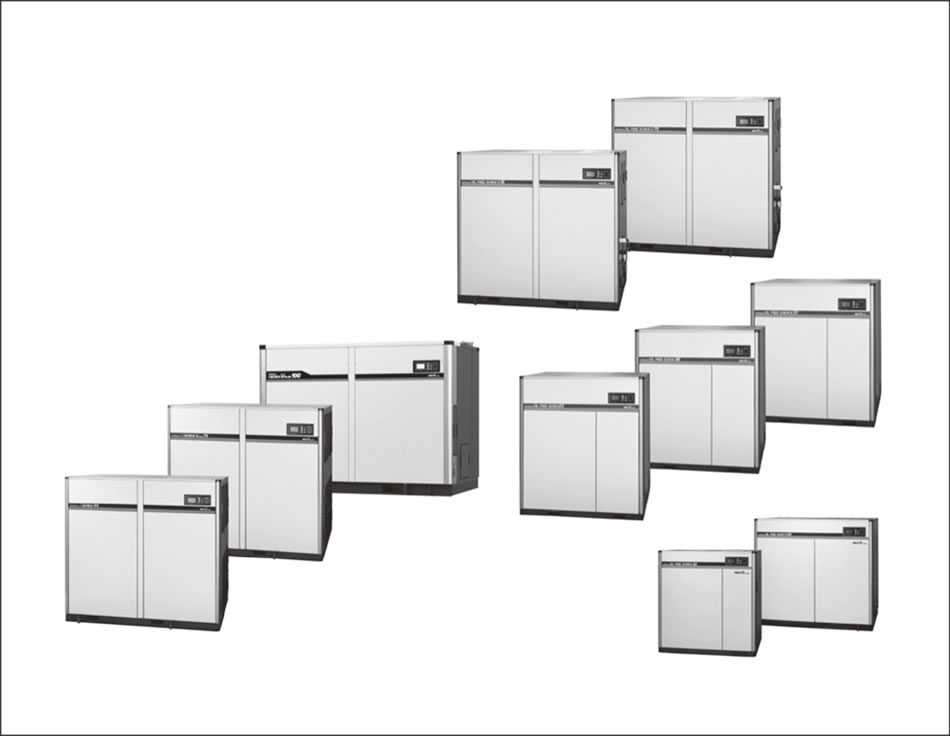 In 22- to 100-kW models of the Hitachi oil-flooded rotary screw compressor series (55/75/100-kW models shown in the figure) and in 15- to 120-kW models of the Hitachi oil-free rotary screw compressor series, (one-stage 22/55-kW and two-stage 22/30/37/55/75-kW models shown in the figure) the air use point pressure prediction control function is installed standard.
In 22- to 100-kW models of the Hitachi oil-flooded rotary screw compressor series (55/75/100-kW models shown in the figure) and in 15- to 120-kW models of the Hitachi oil-free rotary screw compressor series, (one-stage 22/55-kW and two-stage 22/30/37/55/75-kW models shown in the figure) the air use point pressure prediction control function is installed standard.
The energy-saving effect when the pressure loss in the compressed air pipe system is 0.15 MPa and the air consumption ratio is 60% during use of the air use point pressure prediction control function is 7.5% for the model OSP-37VAN2 oil-flooded compressor and 7.2% for the DSP-37VATN2 oil-free two-stage compressor (see Figure 8).
This paper has described the installation of inverters in oil-free compressors and air use point pressure prediction control that reduces operating pressure.
An oil-free scroll compressor directly driven by an amorphous motor introduced in this work successfully obtained even higher energy savings by installation of inverter control in a press switch-type air compressor that already offered excellent energy-saving performance. Hitachi Industrial Equipment Systems performs in-house manufacturing, sales, and servicing of inverters and motors installed in air compressors, and will continue to contribute to reducing CO2 emissions and preventing global warming by quickly proposing and applying these components.
Furthermore, Hitachi air compressors achieve energy saving and high efficiency through various mechanisms and controls in addition to air use point pressure prediction control, and Hitachi will continue to respond quickly to customer needs.